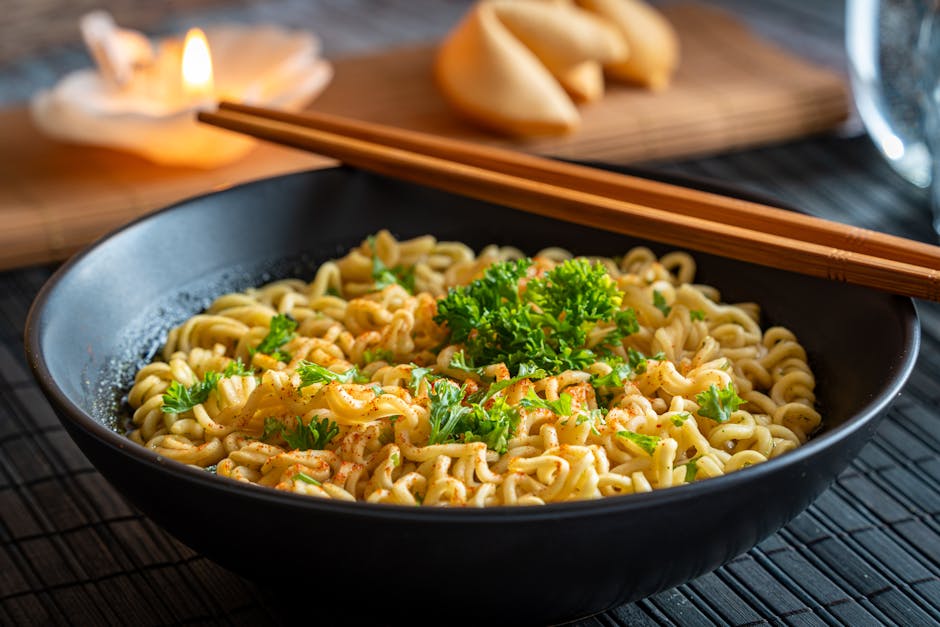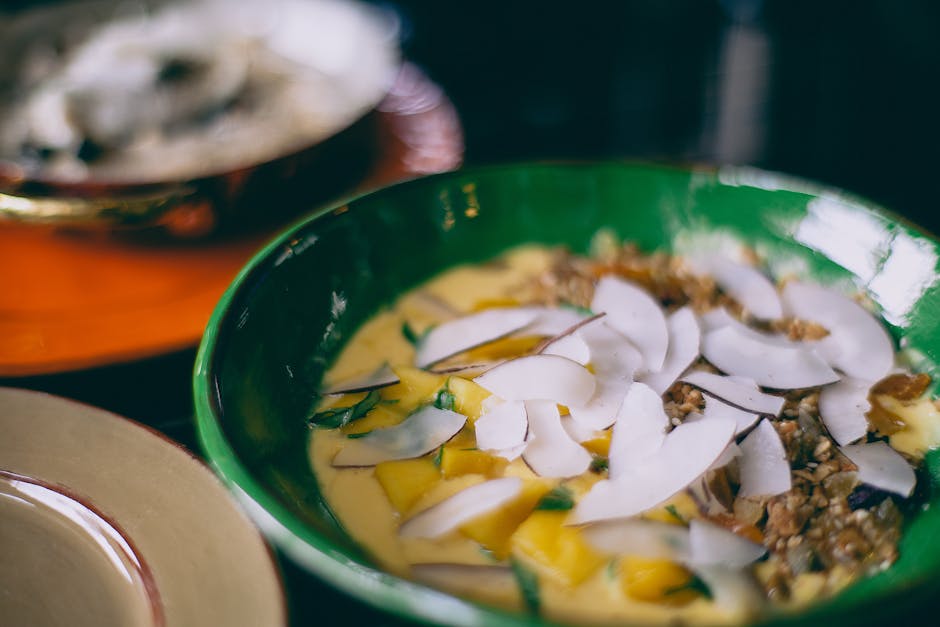Easy Sesame Ginger Noodles, while seemingly simple in its name, represent a delicious fusion of culinary traditions, showcasing the harmonious blend of Asian flavors that have captivated palates worldwide. Pinpointing a single origin is difficult, as noodle dishes incorporating sesame and ginger exist across various East and Southeast Asian cuisines. However, the dish’s core components – noodles, sesame oil, and ginger – boast rich individual histories. Noodles themselves, with evidence suggesting their invention in China as early as 2000 BC, are a staple across numerous cultures, each boasting unique shapes, thicknesses, and preparation methods. Their versatility is a key factor in the dish’s global appeal.
The use of sesame oil, a cornerstone of both Chinese and Japanese cuisine, adds a nutty depth and fragrant aroma to the noodles. Sesame seeds themselves have been cultivated for over 3,000 years, with evidence of their use in ancient Mesopotamia and the Indus Valley Civilization. Their nutritional value, rich in healthy fats and antioxidants, contributed to their integration into various traditional medicinal practices across Asia. Similarly, ginger, a rhizome with a pungent and spicy flavor, holds a significant place in Asian culinary and medicinal traditions. Used for centuries to enhance flavor and provide purported health benefits, its presence in this dish underscores its enduring importance.
The cultural significance of this dish lies in its accessibility and adaptability. Unlike many complex traditional dishes requiring specialized ingredients or techniques, Easy Sesame Ginger Noodles offer a relatively straightforward preparation, making it a popular choice for home cooks of all skill levels. This simplicity, however, doesn’t diminish its cultural value. Noodle dishes, in general, frequently represent comfort food, evoking feelings of nostalgia and home. Globally, noodle consumption is staggering, with an estimated annual consumption exceeding billions of pounds. The ease of preparing Easy Sesame Ginger Noodles reflects a modern appreciation for quick, flavorful, and healthy meals while retaining the comforting essence of traditional Asian cuisine. This dish’s popularity showcases a continued global interest in exploring and adapting Asian culinary traditions to create accessible and delicious meals for modern lifestyles.
The adaptability of Easy Sesame Ginger Noodles is further highlighted by its versatility. The base recipe can be easily customized to include various proteins like chicken, tofu, or shrimp, as well as different vegetables, depending on personal preferences and seasonal availability. This flexibility makes it a perfect example of how traditional culinary foundations can evolve and adapt to meet modern tastes and dietary needs, cementing its place as a beloved and enduring dish.
Ingredients and Measurements
This recipe for Easy Sesame Ginger Noodles yields approximately 4 servings. Accuracy in measurements is key to achieving the perfect balance of flavors and textures, so please use a kitchen scale whenever possible for the most precise results. Volume measurements can vary depending on packing density.
Noodles: We recommend using dried wheat noodles, specifically those designed for stir-fries or ramen. You can easily find these in any Asian grocery store or well-stocked supermarket. For this recipe, you’ll need 8 ounces (225 grams) of dried noodles. Avoid using fresh noodles as they tend to become too soft and mushy when stir-fried.
Sauce: The sauce is the heart of this dish! We’ll be creating a vibrant and flavorful mixture. Start with 1/4 cup (60ml) soy sauce (low sodium preferred for better control of saltiness). Next, add 2 tablespoons (30ml) rice vinegar for a delightful tang. Rice vinegar offers a milder, sweeter acidity than white vinegar. Then, incorporate 2 tablespoons (30ml) sesame oil – this is crucial for that characteristic nutty aroma and richness. Don’t substitute with other oils.
Ginger and Garlic: Fresh ginger and garlic add a fantastic punch of flavor. For this recipe, finely mince 2 tablespoons (10 grams) of fresh ginger. Use a microplane or fine grater for the best results and to avoid large, chunky pieces. Similarly, mince 1 tablespoon (5 grams) of fresh garlic. Again, finely mincing is essential for even distribution of flavor throughout the noodles.
Vegetables (Optional): While not strictly necessary, adding vegetables enhances the nutritional value and adds textural contrast. We suggest using 1 cup (100 grams) of shredded carrots and 1/2 cup (50 grams) of thinly sliced scallions (both white and green parts). Feel free to experiment with other vegetables like bell peppers, broccoli florets, or snap peas, ensuring they are cut into similar sizes for even cooking.
Sesame Seeds: To garnish and add a final layer of nutty flavor, we’ll use 1 tablespoon (5 grams) of toasted sesame seeds. Toasting the sesame seeds beforehand is highly recommended as it brings out their rich flavor significantly. Simply toast them in a dry skillet over medium heat until fragrant, stirring frequently to prevent burning.
Protein (Optional): You can easily add protein to this dish to make it a more substantial meal. Consider adding 4 ounces (115 grams) of cooked chicken, shrimp, or tofu, cut into bite-sized pieces. Ensure your protein is pre-cooked to avoid overcooking it when you combine it with the noodles.
Important Note: Taste and adjust the sauce to your preference. You might want to add more soy sauce for saltiness, rice vinegar for tang, or sesame oil for richness. Always taste before serving and adjust accordingly.
Preparation: Mise en Place (Prepping Ingredients)
Before you even think about firing up the stove, mastering the art of mise en place – French for everything in its place – is crucial for a smooth and efficient cooking process. This ensures your Easy Sesame Ginger Noodles come together quickly and flawlessly. For this recipe, proper preparation means having all your ingredients measured, chopped, and readily accessible before you begin cooking.
Let’s start with the noodles. We’ll be using 8 ounces (225g) of dried noodles – your choice of thin spaghetti, egg noodles, or even linguine will work beautifully. Ensure the noodles are at room temperature before cooking; this helps them cook evenly and prevents sticking. While the noodles are not technically part of the mise en place *during* prep, preparing them in advance saves time later.
Next, we tackle the vegetables. We need 1 cup (about 100g) of shredded carrots. Use a box grater or food processor for speed and consistent shredding. Avoid over-shredding, as this can lead to mushy carrots. For the scallions, finely slice 4 (about 1/4 cup) and set aside 2 tablespoons for garnish. The vibrant green adds a pop of color and fresh flavor.
Now onto the ginger and garlic. We’ll use 1 tablespoon of freshly grated ginger and 2 cloves of minced garlic. Freshly grated ginger offers a superior flavor and aroma compared to pre-ground. If using pre-ground, reduce the quantity slightly, as it’s more concentrated. Mince the garlic finely to ensure even distribution throughout the sauce. For those who prefer a milder garlic flavor, you can use less or even substitute with garlic powder.
For the sauce, measure out all ingredients precisely. We’ll need 1/4 cup (60ml) of soy sauce (or tamari for gluten-free), 2 tablespoons of rice vinegar, 1 tablespoon of sesame oil (toasted sesame oil is recommended for its richer flavor), 2 tablespoons of honey or maple syrup (adjust to your desired sweetness level), and 1 tablespoon of cornstarch. Whisk the sauce ingredients together thoroughly in a small bowl to ensure a smooth, lump-free consistency. This prevents a grainy sauce.
Finally, prepare your protein (optional). If adding protein, such as cooked chicken or shrimp (about 1 cup cooked), ensure it’s already cooked and chopped or shredded into bite-sized pieces. Pre-cooking your protein saves valuable time during the cooking process, allowing you to concentrate on the noodles and sauce. If using tofu, press it to remove excess water before adding it to the noodles.
With all your ingredients prepped and ready, you’re now poised for a quick and effortless cooking experience. This careful preparation ensures a delicious and perfectly balanced bowl of Easy Sesame Ginger Noodles every time.
Noodle Cooking
Cooking noodles perfectly is the foundation of a delicious bowl of Sesame Ginger Noodles. While seemingly simple, there are a few key techniques to ensure your noodles are cooked al dente and ready to absorb the flavorful sauce.
This recipe calls for 8 ounces (225 grams) of dried noodles. You can use any type of noodle you prefer – spaghetti, linguine, fettuccine, or even wider, flat noodles all work well. Avoid using very thin noodles like angel hair, as they tend to become mushy easily. Look for noodles that are made with high-quality ingredients for the best texture and flavor.
Bring a large pot of salted water to a rolling boil. The amount of water is crucial; you need enough to ensure the noodles don’t stick together. Aim for at least 6 cups (1.4 liters) of water for 8 ounces of noodles. Adding salt to the boiling water is essential. It seasons the noodles from the inside out and enhances their overall flavor. Use about 1 tablespoon of salt per 6 cups of water – you can adjust to your taste.
Once the water is boiling vigorously, add the noodles all at once. Stir gently to prevent them from sticking together. Avoid breaking the noodles before adding them to the pot; usually, they will soften enough to easily separate once they are cooking.
Cook the noodles according to the package directions. This is usually around 8-10 minutes for most dried noodles, but always check the package for the most accurate cooking time. The recommended cooking time is a guideline; you might need to adjust it slightly depending on your stove and the type of noodles you are using.
To check for doneness, taste a noodle. It should be tender but still have a slight resistance to the bite – this is the al dente stage. If it’s too soft, you’ve overcooked it. If it’s too firm, continue cooking for a minute or two and check again.
Once the noodles are cooked to your liking, immediately drain them in a colander. Rinse the noodles under cold water for about 30 seconds to stop the cooking process and prevent them from sticking together. This also helps remove excess starch, which can prevent the sauce from clinging properly.
Important Note: Don’t rinse the noodles if you plan on serving them immediately with a sauce that contains oil or fat. The oil will help prevent sticking. However, rinsing is highly recommended if there is a delay between cooking and serving.
Now that your noodles are perfectly cooked, they’re ready to be tossed with the delicious sesame ginger sauce! Enjoy!
Sauce Preparation
The vibrant and flavorful sauce is the heart of these Easy Sesame Ginger Noodles. Getting the balance right is key to a truly delicious dish, so take your time and follow these steps carefully. We’ll be creating a luscious sauce that’s both sweet, savory, and subtly spicy – a perfect complement to the noodles and your choice of protein.
Begin by whisking together the base of your sauce. This ensures a smooth, emulsified texture without any lumps. In a medium-sized bowl, combine 1/4 cup of soy sauce (low sodium preferred for better flavor control), 2 tablespoons of rice vinegar (for a bright acidity), and 2 tablespoons of sesame oil (toasted sesame oil adds a richer flavor). Whisk vigorously for about 15 seconds until everything is thoroughly combined. The sesame oil will help to bind the other ingredients and create a glossy finish.
Next, we’ll add the aromatics. This is where the ginger and garlic shine. Finely mince 2 cloves of garlic and 1 inch of fresh ginger. If you prefer a milder ginger flavor, you can grate it instead of mincing. Add the minced garlic and ginger to the sauce mixture. A crucial tip here is to use fresh ginger; it offers a superior flavor and aroma compared to ground ginger. If using ground ginger, start with 1/2 teaspoon and adjust to taste.
Now for the sweetness and a touch of heat. Add 2 tablespoons of honey or maple syrup (for a vegan option) to the sauce. This balances the saltiness of the soy sauce and adds a delightful sweetness. For a subtle kick, add 1/2 to 1 teaspoon of red pepper flakes, depending on your spice preference. Start with the smaller amount and taste before adding more; you can always add more heat, but you can’t take it away! Remember that the heat from the chili flakes will intensify as the sauce sits.
Finally, incorporate the sesame seeds. Add 2 tablespoons of sesame seeds (a mix of white and black sesame seeds adds visual appeal) to the sauce. These add a nutty flavor and pleasing texture. Give the sauce one last good whisk to make sure everything is evenly distributed. Taste the sauce and adjust the seasoning as needed. You might want to add a little more soy sauce for saltiness, honey for sweetness, or rice vinegar for acidity. Don’t be afraid to experiment!
Important Note: Allow the sauce to sit for at least 10-15 minutes before using. This allows the flavors to meld together and deepen, resulting in a more complex and delicious sauce. You can even prepare the sauce ahead of time and store it in the refrigerator for up to 3 days. Bring it to room temperature before using.
Combining Noodles and Sauce
This section details the crucial step of combining your perfectly cooked noodles with the vibrant sesame ginger sauce, ensuring a delicious and well-coated final product. The key is to achieve a balance – enough sauce to coat every strand of noodle without leaving it swimming in excess liquid. We’ll guide you through the process for optimal results.
First, ensure your noodles are thoroughly drained. Any residual water will dilute the sauce, compromising its flavour and texture. Don’t just tip them into a colander; give them a good shake to remove as much excess water as possible. A gentle press with the back of a spoon can help further reduce moisture if necessary. This step is crucial for preventing a watery noodle dish.
Next, add your cooked noodles to a large bowl. A large bowl allows for easier mixing and prevents the noodles from sticking together. Using tongs or chopsticks is ideal for gently lifting and separating the noodles, preventing them from breaking. Avoid using a spoon as it can crush the noodles, especially if they are delicate.
Now for the sauce! Gradually pour the prepared sesame ginger sauce over the noodles. Start with about ¾ of the total sauce, reserving the remaining ¼ for later adjustment. This allows you to control the consistency and avoid over-saucing. We recommend using approximately 1/2 cup of sauce for 8 ounces of noodles, but adjust this depending on your preference and the thickness of your sauce.
Using tongs or chopsticks, carefully toss the noodles and sauce together. This is where patience and a gentle hand are essential. Vigorously tossing the noodles can break them, resulting in a less appealing dish. Instead, use a lifting and folding motion to ensure every strand is evenly coated. The goal is to create a glossy, well-integrated mixture where the sauce clings to each noodle.
Taste the noodles and assess the sauce consistency. If the noodles seem dry, add a little more of the reserved sauce, a tablespoon at a time, until you achieve your desired level of moistness. Conversely, if the sauce is too thick or the noodles are overly saturated, you can add a teaspoon or two of warm water to thin it out. This step allows you to personalize the dish to your liking.
Finally, garnish and serve immediately. The sesame ginger noodles are best enjoyed while the sauce is still warm and the noodles maintain their texture. Garnish with toasted sesame seeds, chopped green onions, or a sprinkle of chili flakes for an extra layer of flavor and visual appeal. Serve hot and enjoy your delicious, homemade sesame ginger noodles!
Important Note: If you are making the noodles ahead of time, store the noodles and sauce separately to prevent the noodles from becoming soggy. Combine them just before serving for optimal texture and flavour.
Garnish and Plating: Elevating Your Sesame Ginger Noodles
The final touch to any dish is the garnish and plating. For your Easy Sesame Ginger Noodles, this step is crucial in transforming a simple meal into a visually appealing and delicious experience. Even small details can make a significant difference, elevating the overall presentation and enhancing the dining experience.
Start with the base: Begin by considering your serving vessel. A shallow bowl allows for a visually appealing spread of noodles, while a deeper bowl might be better for dishes with more sauce. A simple white bowl allows the vibrant colors of your garnish to stand out.
Noodle Arrangement: Don’t just dump the noodles into the bowl! Gently toss the noodles to ensure even sauce distribution, then arrange them neatly. You can create a small nest in the center, or arrange them in a slightly fanned shape to allow for optimal visual appeal. Avoid overcrowding the bowl; leave some negative space to balance the composition.
Garnish Selection: The garnish should complement the flavors of the noodles and add visual interest. Here are some excellent options, with suggested quantities for a single serving:
- Sesame Seeds (1 teaspoon): Toasted sesame seeds add a delightful crunch and enhance the sesame flavor of the dish. Sprinkle them generously over the noodles.
- Chopped Green Onions (1 tablespoon): Their bright green color provides a beautiful contrast and adds a fresh, slightly oniony flavor. Scatter them artfully over the noodles.
- Sliced Red Chili (1/2 -1 small chili): For a touch of heat and a splash of vibrant red, add thinly sliced red chili. Adjust the quantity based on your spice preference. If using a particularly spicy chili, consider finely mincing it to distribute the heat evenly.
- Fresh Cilantro (1 tablespoon): A small amount of chopped cilantro adds a fragrant and refreshing element. It’s best to use it sparingly, as too much can overpower the other flavors.
- Optional additions: Consider adding other elements like toasted slivered almonds (1 tablespoon) for added crunch, or a sprinkle of finely grated ginger (1/4 teaspoon) for an extra kick.
Plating Techniques: A simple yet elegant approach is key. Avoid overcrowding the bowl with garnish. Instead, arrange the elements thoughtfully, creating visual balance. Use a spoon or chopsticks to carefully place the garnish, arranging it in small clusters or strategically spaced accents rather than scattering it randomly.
Sauce Drizzle: A final drizzle of extra sesame ginger sauce adds both flavor and visual appeal. Use a spoon to create a delicate stream of sauce across the noodles, or create small pools of sauce around the garnish. This adds both a glossy finish and a touch of sophistication.
Professional Tip: Before plating, ensure your noodles and garnish are at room temperature or slightly cool. This helps prevent the garnish from wilting and allows for better control during the plating process. Photography Tip: Good lighting and a clean background will enhance the visual appeal of your dish. Consider using a dark background to make the colors of the noodles and garnish pop.
By paying attention to these details, you can transform your Easy Sesame Ginger Noodles from a simple dish into a culinary masterpiece. Remember, the goal is to create a visually stunning presentation that complements the delicious flavors of your creation.
Easy Sesame Ginger Noodles: Recommendations
These Easy Sesame Ginger Noodles are a delicious and versatile dish perfect for a quick weeknight meal or a more elaborate lunch. To maximize enjoyment and ensure optimal freshness, we offer the following recommendations:
Serving Suggestions: For a complete and satisfying meal, consider serving your Easy Sesame Ginger Noodles with a variety of accompaniments. A sprinkle of chopped scallions or cilantro adds a fresh, vibrant touch and enhances the overall flavor profile. Toasted sesame seeds provide a delightful crunch and amplify the nutty sesame flavor. A squeeze of fresh lime juice at the end brightens the dish and adds a touch of acidity to balance the richness of the sauce. For added protein, consider grilling some chicken, shrimp, or tofu and adding it to the noodles. Crispy vegetables like shredded carrots or bell peppers also make a wonderful addition, adding both texture and nutrients.
Storage and Reheating: For best results, consume your Easy Sesame Ginger Noodles immediately after preparation. However, if you have leftovers, store them in an airtight container in the refrigerator for up to 3 days. To reheat, gently warm the noodles in a pan over medium heat, adding a splash of water or soy sauce if needed to prevent sticking. Avoid microwaving, as this can result in a mushy texture. Do not refreeze.
Complementary Dishes: The versatility of these noodles makes them ideal for pairing with a range of complementary dishes. A light and refreshing side salad with a simple vinaigrette would create a balanced and satisfying meal. For a more substantial meal, consider serving the noodles alongside potstickers, spring rolls, or edamame. The ginger and sesame flavors pair particularly well with Asian-inspired dishes such as miso soup or a simple seaweed salad. If you’re looking for a heartier option, a side of steamed rice or quinoa would complement the noodles perfectly.
Nutritional Information (per serving, approximate): The exact nutritional content will vary depending on the specific ingredients used and portion size. However, a typical serving of Easy Sesame Ginger Noodles will contain approximately 350-450 calories. This includes a good source of carbohydrates from the noodles, healthy fats from sesame oil and potentially added nuts or seeds, and some protein depending on additions like tofu or chicken. The dish is also a good source of fiber and various vitamins and minerals, depending on the vegetables included. Please note: This is an estimate, and accurate nutritional information should be calculated based on your specific recipe and ingredient quantities.
Important Note: Always check ingredient labels for allergens and adjust seasonings to your personal preference. Enjoy experimenting with different additions to create your own unique version of these delicious and customizable Easy Sesame Ginger Noodles!





